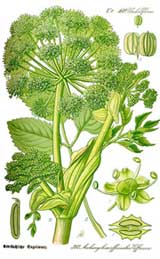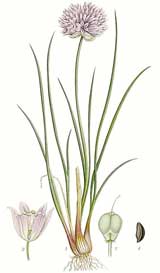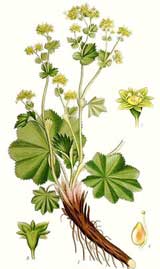Designing Ornamental Gardens with Edible Plants
Many edible plants can be used in ornamental gardens. Not only will your garden look nice but you can eat it!
Please read the web pages Before you start and Design Tips. More information on edible ornamentals
In the design below we have chosen warm vibrant colours and strong foliage to give impact to the garden. Purple has been used as the dominant flower colour. To add more themed colour you could also add some plants with the same leaf colour for example, using a purple sage (but don't overdo it!).
Plants have been chosen for a garden that requires hardy plants, has a moist (normal), medium (loamy) soil with a neutral pH, and is in full sun. Below the plan more information has been given on each plant used. This information has been taken directly from the database to show how the plants suit the garden conditions.
|
1. Angelica archangelica
  
  
|
 |
BIENNIAL growing to 1.5 m (5ft) by 0.8 m (2ft 7in).
It is hardy to zone 4 and is not frost tender. It is in flower from Jul to August, and the seeds ripen from Aug to September. The flowers are hermaphrodite (have both male and female organs) and are pollinated by Insects.The plant is self-fertile.
It is noted for attracting wildlife.
The plant prefers light (sandy), medium (loamy) and heavy (clay) soils.The plant prefers acid, neutral and basic (alkaline) soils. and can grow in very acid soils.
It can grow in semi-shade (light woodland) or no shade.It requires moist soil. |
|
2. Foeniculum vulgare
    
  
|
 |
An evergreen Perennial growing to 1.5 m (5ft) by 1 m (3ft 3in).
It is hardy to zone 5 and is not frost tender. It is in leaf 12-Jan It is in flower from Aug to October, and the seeds ripen from Sep to October. The flowers are hermaphrodite (have both male and female organs) and are pollinated by Insects.The plant is self-fertile.
It is noted for attracting wildlife.
The plant prefers light (sandy), medium (loamy) and heavy (clay) soils and requires well-drained soil.The plant prefers acid, neutral and basic (alkaline) soils..It cannot grow in the shade.It requires dry or moist soil and can tolerate drought.The plant can tolerates strong winds but not maritime exposure. |
|
3. Lavandula angustifolia
 
  
|

|
An evergreen Shrub growing to 1.2 m (4ft) by 1 m (3ft 3in).
It is hardy to zone 5. It is in leaf 12-Jan It is in flower from Jul to September, and the seeds ripen from Aug to October. The flowers are hermaphrodite (have both male and female organs) and are pollinated by Bees, lepidoptera.It is noted for attracting wildlife.
The plant prefers light (sandy), medium (loamy) and heavy (clay) soils and requires well-drained soil.The plant prefers acid, neutral and basic (alkaline) soils. and can grow in very alkaline and saline soils.
It cannot grow in the shade.It requires dry or moist soil and can tolerate drought.The plant can tolerate maritime exposure. |
|
4. Salvia officinalis
  
    
|

|
An evergreen Shrub growing to 0.6 m (2ft) by 0.6 m (2ft in).
It is hardy to zone 5 and is not frost tender. It is in leaf 12-Jan It is in flower from Jun to August, and the seeds ripen from Aug to September. The flowers are hermaphrodite (have both male and female organs) and are pollinated by Bees.
The plant prefers light (sandy) and medium (loamy) soils and requires well-drained soil.The plant prefers neutral and basic (alkaline) soils. and can grow in very alkaline soils.
It cannot grow in the shade.It requires dry or moist soil and can tolerate drought. |
|
5. Iris germanica

  
|
 |
PERENNIAL growing to 1 m (3ft 3in) by 1.5 m (5ft).
It is hardy to zone 5 and is not frost tender. It is in flower from May to June. The flowers are hermaphrodite (have both male and female organs) and are pollinated by Insects.The plant is self-fertile.
The plant prefers light (sandy) and medium (loamy) soils and requires well-drained soil.The plant prefers acid, neutral and basic (alkaline) soils. and can grow in very alkaline soils.
It can grow in semi-shade (light woodland) or no shade.It requires dry or moist soil. |
|
6. Allium schoenoprasum sibiricum
    
 
|
 |
BULB growing to 0.3 m (1ft) by 0.3 m (1ft in).
It is hardy to zone 5 and is not frost tender. It is in flower from Jul to August. The flowers are hermaphrodite (have both male and female organs) and are pollinated by Bees, insects.
The plant prefers light (sandy), medium (loamy) and heavy (clay) soils, requires well-drained soil and can grow in heavy clay soil.The plant prefers acid, neutral and basic (alkaline) soils..It can grow in semi-shade (light woodland) or no shade.It requires moist soil. |
|
7. Alchemilla xanthochlora
 
  
|
 |
PERENNIAL growing to 0.3 m (1ft) by 0.3 m (1ft in).
It is hardy to zone 5 and is not frost tender. It is in flower from Jun to September, and the seeds ripen from Aug to October. The flowers are hermaphrodite (have both male and female organs) and are pollinated by Apomictic.The plant is self-fertile.
The plant prefers light (sandy), medium (loamy) and heavy (clay) soils, requires well-drained soil and can grow in heavy clay soil.The plant prefers neutral and basic (alkaline) soils..It can grow in semi-shade (light woodland) or no shade.It requires dry or moist soil. |
The database has details of more edible ornamentals: Adenophora latifolia, Allium senescens, Allium victorialis, Asclepias latifolia, Campanula latifolia, Campanula rapunculoides, Canna indica, Codonopsis lanceolata, Codonopsis ovata, Codonopsis pilosula, Codonopsis ussuriensis, Commelina coelestis, Erythronium americanum, Erythronium dens-canis, Lilium bulbiferum, Lilium candidum, Lilium lancifolium, Lilium pardalinum, Lilium speciosum, Oxalis deppei, Smilacena racemosa, Smilacena stellata, Tigridia pavonia, Viola mandschurica, Viola tricolor.